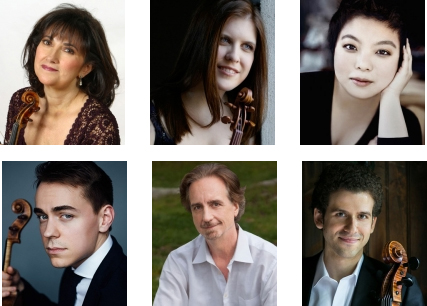by Daniel Hathaway

Except for half a dozen works by Boccherini that were designed to show off his talents as a composer-cellist, the string sextet as we know it was single-handedly invented by Johannes Brahms in the 1830s. Quaking at the idea of writing a string quartet and being compared to Beethoven, Brahms decided to write for the combination of two violins, two violas, and two cellos.
On Tuesday, violinists Ani Kavafian and Erin Keefe, violists Yura Lee and Matthew Lipman, and cellists Nicholas Canellakis and David Finckel demonstrated how appealing this combination of six string players can be. As wide a range of effects that the string quartet can produce, it can’t approach the string sextet for mellowness and resonance of sound, especially in the middle range, where an extra viola and cello make the most difference.
Richard Strauss recognized that potentiality when he decided to use a string sextet as the prelude to his fifteenth and final opera, Capriccio. It sets the scene for an unlikely plot: a chamber music house party of musical aficionados who are about to spend the evening discussing the relationship of words to music in opera. The six players opened Tuesday’s concert with a rich performance of Strauss’s brief but thickly-embroidered piece.
Here, the Lincoln Center folks might have wanted to rethink the order of things. They continued with Dvořák’s Op. 48 Sextet, a work inspired by Brahms’s two string sextets, but which seems far more vibrant and inventive. The addition of Bohemian folk elements in Dvořák’s piece (in the second movement, “Dumka,” and the third movement, “Furiant”) add a vitality to this sextet that made Brahms’s Sextet No. 2 in G, Op. 36, charming as it is, seem pale by comparison as the conclusion to the concert. The Dvořák would have made a stunning closer.
Needless to say, the playing of these six musicians — an intergenerational group that includes veterans of the chamber music circuit as well as splendid new recruits — was accomplished and masterful. In addition to luxuriating in their sonic opulence, it was fun to watch the personal interactions among the six performers. David Finckel, obviously the paterfamilias of the group, cast wise, knowing glances at his colleagues throughout the proceedings, while Nicholas Canellakis and Matthew Lipman seemed to have a running joke going during the Dvořák and Brahms. No jaded musicians among them, they were all having a great time, and so was the audience. There was no encore, though the crowd would have welcomed one.
Published on ClevelandClassical.com May 3, 2016.
Click here for a printable copy of this article



